Although the bathroom is not living room, but its dimensions play a significant role. The larger the area, the more opportunities you have for. However, in some cases, the area of \u200b\u200ban apartment or house does not allow us to spend extra meters, and we are trying to win them due to the size of the bathroom. But there are also SNiP standards that dictate the minimum footage of latrines and baths.
In this article, we will talk about such standards, as well as how to choose the optimal area.
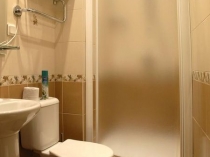

How the size is determined
When choosing parameters, we must start from the standards for SNP, in which the minimum area is regulated and standard sizes bathroom. You should also consider comfortable distance between the plumbing. All necessary numbers are given below.
Minimum bathroom dimensions
Strictly speaking, for general cases, the statute is only for latrines: minimum width bathroom 80 cm, and height 120 cm. The ceiling height inside should be from 250 cm, and in the corridor in front of the toilet 210 cm.For attic apartments, there is an additional rule: the distance from the roof plane to the toilet bowl should be at least 105 cm.
And separately there are the minimum dimensions of the bathroom for apartments and houses where disabled people live. A bathroom or a combined bathroom should be an area of \u200b\u200b2.2x2.2 m, and a restroom from 1.6x2.2 m.It should also be said that SNiP norms are mandatory in apartment buildings, and in individual buildings you can try to get around the rules.
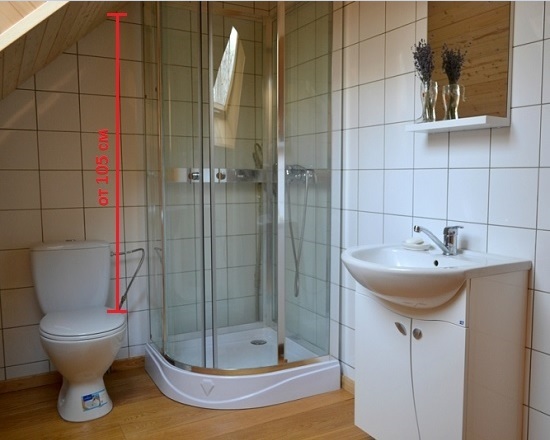
Dimensions of the bathroom, combined. The correct distance from the toilet to the roof slope of the attic
Typical parameters of restrooms and bathrooms
Also, according to the SNiP standards, there are the following typical sizes of bathrooms in a panel house and in Khrushchev:
- Restroom with toilet and washbasin - 1x1.5 m 2.
- Bathroom with a washbasin - 1.5x2 m 2.
- Joint bathroom - 1.98x1.73 m 2, 2.5x1.5 m 2.
- With a shower instead of a bath - 1.4x1.6 m 2.
These parameters are given for typical apartment buildings, and you can round up the size of a bathroom in a private house: 4 sq m instead of 3.8 sq m, 3 m 2 instead of 2.24, etc.
Note: violation of standard dimensions in the big direction is not limited in any way. That is, you can easily make a large bathroom with an area of \u200b\u200b6 sq m, 7 sq m, 8 sq m, etc. You just need to remember correct distance plumbing from communications.
The dimensions of the bathroom, SNiP. In private homes, you can deviate from them.
Selection of optimal dimensions
As mentioned above, if you are setting up a restroom or, then, you are not as tightly tied to regulations as the apartment owners. However, when choosing the size of a bathroom in residential buildings, it is still worth considering some nuances. Their observance will make the use of the premises comfortable. Recommended distances between plumbing:
- There should be at least 70 cm from the bath or shower to other plumbing.
- If there are two washbasins, then the distance between the sinks is from 65 cm.In front of the washbasin - from 70 cm, between it and the adjoining wall - 20 cm.
- Free space in front of the toilet - from 60 cm, to the sides to other plumbing fixtures or walls - from 40 cm.
- Door width - from 55 cm
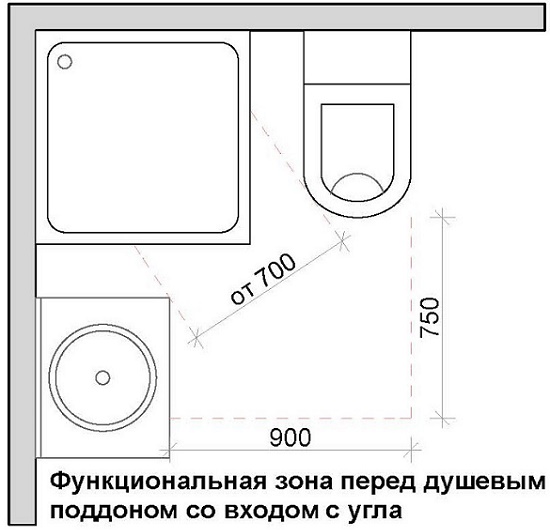
When buying a new home, few people pay attention to the size of the bathroom. But this room is one of the most frequently used in an apartment / house. Therefore, it is very important that the bathroom is of sufficient area so that at least a minimum of furniture can be in it, and at the same time it is comfortable to use it.
In this article, we will consider the standards by which bathrooms are built, their minimum and typical sizes.
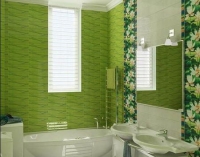

How to choose the right size of the future bathroom, optimal dimensions
In order for the bathroom to be functional and easy to use for each family member, you should know the optimal sizes of bathrooms in residential buildings:
- room width - at least 80 cm;
- height - about 250 cm;
- depth - at least 120 cm.
Having removed the dimensions, you can rationally use its area when placing plumbing. The toilet should be approached at least 60 cm and 25 cm to the left and right of it. To access the sink, 70 cm is left, the comfortable height of its location is 80-90 cm.Free access to the bathroom or shower is 70-120 cm.
On a note: as an unspoken rule, frequently used items in the bathroom should be within the reach of the hand.
Plumbing installation rules
Sizes, as a rule, are not as limited as in a city apartment, therefore, they can accommodate any plumbing. But for multi-storey buildings, it is better to choose compact models.
Typical sizes of bathrooms
Consider the options for the layout of the premises with standard sizes of the bathroom.
Small rooms of 2x2 m, as well as 1.5x2 m, are the minimum area that a person needs. If the bathroom and toilet are separate, it makes sense to combine them and expand the usable space.
On a note: this type of redevelopment, which does not involve the transfer of pipes, is coordinated according to a simplified scheme.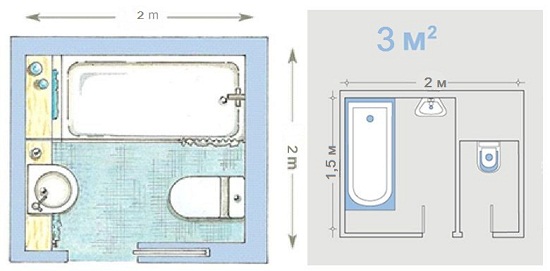
Examples of the layout of mini-bathrooms with an area of \u200b\u200b2 sq. meters and 3 m2
Bathroom from 4 sq. m up to 6 sq. m. already has enough space to be equipped with a washing machine, a small cabinet for things. Depending on the location of the door, plumbing can be placed either around the perimeter of the room or on opposite sides.
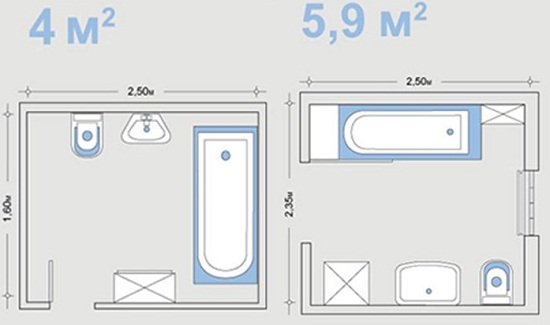
Layout of medium-sized bathrooms in a panel house
Indoors 7 sq. m. fit the necessary plumbing and household appliances. If many people live in the apartment, you can install two sinks, or a second bathing tank.
Advice: it is advisable to divide a large bathroom into functional areas.
Layout options for a bathroom 7 sq. m.
If the bathroom is narrow and long, then the bathing tank is installed at the very depth of the room. The toilet, sink and bidet are best positioned along the walls in the order in which they are most commonly used.

Methods for planning a narrow bathroom
Minimum sizes of bathrooms
Bathrooms and toilets in apartments of different sizes and houses different types differ in area and configuration. Determines the minimum dimensions of the bathroom SNiP (full name " Sanitary standards and rules ") for residential premises.
The minimum dimensions for a separate toilet, complete with a toilet bowl and a sink, depend on the way the door is opened in the room. The size of the doorway of the bathroom and toilet is 75x210 cm, the width of the door is 60-70 cm.
If, then for convenient use there will be enough space of 0.9x1.15 m.If the door opens inside the room, taking away part of its area, then the minimum dimensions of the toilet are 0.9x1.45 m.

Minimum toilet dimensions
Can be equipped with a washbasin, shower tray and toilet. The minimum dimensions of such a combined room are 1.65x2 m, or 1.45x2.2 m.If the toilet is located separately, the dimensions of the bathroom can be 1.35x1.65 m.
Many apartment owners would probably like to know what the minimum size of the bathroom should be, and what area is considered optimal for this room. Do I need to do a redevelopment, combining a toilet with a bath, or is this operation optional? Or maybe it is worth adding a part of the adjacent territory to the toilet: a corridor or a storage room?
It is useful to find out what dimensions this room should have for the owners of suburban areas who decide to build a house.
Choosing the size of the bathroom
A comfortable bathroom should not only contain all the necessary plumbing, but also be spacious enough for a comfortable visit.

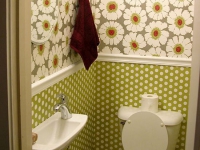
According to SNiP standards:
- Free space in front of the bathroom should be 70-110cm.
- On both sides of the toilet - 25cm area, and in front of it - 60cm.
- In front of the sink - 70cm.
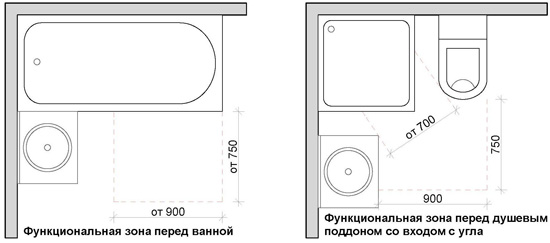
There should be 70-75 cm of functional space in front of the bathroom
Based on this, you can calculate the optimal size of a bathroom for a city apartment. Usually, a sink with a toilet in such a room is located along one wall, and a bathtub or shower stall is installed near the adjacent one. The optimal functional area next to the washing machine is 90 cm.

A place for a washing machine should be provided in the restroom.
Therefore, 2x2-2.5x2.5m is the approximate optimal size of a bathroom in a private house of a small area (combined) and in a city apartment. A convenient area for a divided washroom would be:
- bathroom - 1.5x2 meters,
- toilet - 0.9x1.5 meters.
These figures are approximate. In fact, it all depends on what dimensions the apartment has.
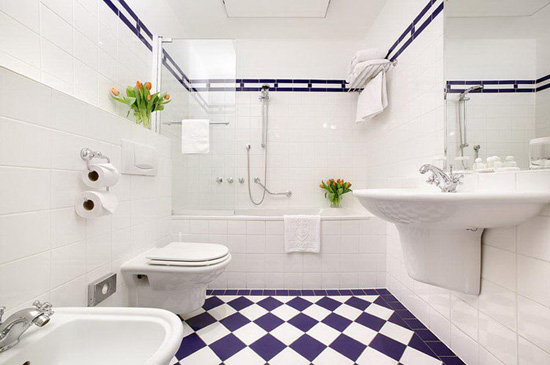
The optimal size of bathrooms in residential buildings and apartments. Photo of a comfortable room 6m2
Important: When drafting a house or redeveloping an apartment, keep in mind that according to the standards, residential premises should account for at least 80% of the area. For the bathroom, kitchen, hallway and storage room, respectively, 20% remains.Most cottages usually have only combined toilets, the area of \u200b\u200bwhich is about 5-9 square meters.

Large bathroom of a country cottage
Typical washroom sizes
So, the approximate optimal area of \u200b\u200ba combined toilet in a typical apartment is 4-6 sq m, divided - 3 m2 for a bathroom and 1.4 m2 - for a bathroom. What is the real state of affairs? The standard dimensions of the bathroom, if divided, in a small apartment are:
- 0.88, 1.2, 1.5, 1.7, 1.8m2 - toilet,
- 2 square meters and 2.5 square meters - bathroom.

The length and width of the bathroom in typical small-sized apartments are usually far from optimal
That is, a bath in Khrushchev before optimal sizes clearly falls short. The space in the toilet is not very efficiently distributed. Consequently, combining these premises in a small apartment is an expedient matter. After completing this procedure, you can increase the usable area of \u200b\u200bthe toilet due to the thickness of the partition and it is more convenient to arrange the plumbing.

Arrange plumbing after combining in the restroom can be more rational
In a typical Soviet-built apartment, the standard dimensions of a bathroom combined with a bathtub are usually 3-4 square meters. The area, of course, is also not enough, but in this case it will hardly be possible to change anything.
Idea: If a pantry is adjacent to the combined bathroom in the Khrushchev, you can try to attach it too. Sometimes the owners of such restrooms also combine them with an adjoining corridor, arranging an entrance to the kitchen from the living room.
You can increase the area of \u200b\u200ba typical restroom by combining it with a pantry
The minimum dimensions of the bathroom
In Soviet times, the minimum permissible size of bathrooms was rarely observed. Therefore, many owners of small-area apartments with very tiny toilets will probably be interested to know what they should be in reality. So,
The dimensions of the bathroom SNiP (in meters) are determined as follows:
- ceiling height - 2.5 (in the attic - 1.05);
- the minimum width of a separate toilet is 0.8;
- length -1.2;
- the height of the corridor in front of the toilet is 1.1.
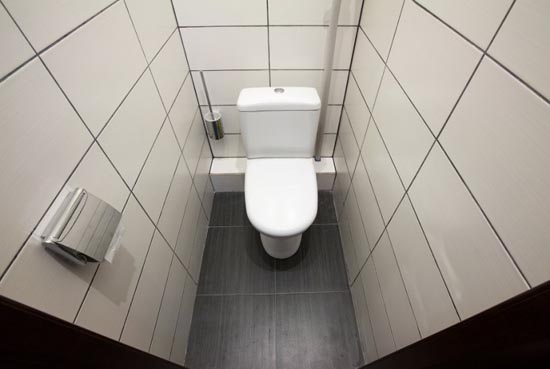
Typical toilet in a Khrushchev building 1.2x0.8m2
Doors (the width of which by standards is 55-60cm without jambs) must open outward. The minimum dimensions of a shared bathroom, as well as a separate bathroom, SNiP, unfortunately, are still not regulated.
The conclusion from all that has been said is the following. Choosing the size of the restroom when drafting a house and when redeveloping an apartment should be guided by existing standards, as well as common sense and your own ideas about convenience.
Often when buying a new home, owners do not pay attention to the size of the bathroom. But in vain, because a person spends a lot of time in this room every day. Therefore, it makes sense to consider the question of what norms exist regarding standards and minimum sizes, as well as how to make the small space of a typical bathroom as ergonomic as possible.
There are clear standards as to what should be the size of the bathroom according to SNiP (Sanitary Norms and Rules). Main settings:
- Sizes of bathrooms in residential buildings and public buildings:
- width - at least 80 cm;
- ceiling height - not less than 2.5 m;
- depth - not less than 1.2 m.
- When the toilet is located in attic room the distance from the toilet bowl to the sloped roof is at least 1.05-1.1 m.
- The doors only open outward.
- The exit should not be located in the living area or kitchen, exclusively in the hallway or corridor.
- Requirements for the corridor near the bathroom: ceiling height - at least 2.1 m.
It is important to consider the size of the combined bathroom and the requirements for installing plumbing. If, in addition to the toilet, other equipment (bidets, sinks, bathtubs) is installed, SNiP provides for the following standards:
- there should be a free space of at least 0.7 m in front of the shower or bath;
- the bidet is located at a distance of at least 0.25 m from the toilet (if the plumbing model does not provide for two functions at the same time);
- there should be a free space of at least 0.25 m on the left and right of the toilet;
- there must be a free space of at least 0.6 m in front of the toilet;
- there is a free space of at least 0.7 m in front of the sink.
Standard distances between plumbing equipment in the bathroom
The minimum dimensions of the bathroom prescribed in SNiP must be taken into account when constructing new buildings. These norms apply to the entire territory of Russia.
Requirements for the arrangement of bathrooms for the disabled
It is also important to know what the size of the bathrooms in public buildings visited by people with disabilities should be. These rules are also established by SNiP:
- toilet and cubicle doors open outward;
- booth width - not less than 1.65 m;
- the depth of the booth is at least 1.8 m.
But such standards are valid not only for public buildings, but also for houses and apartments in which disabled people live. Here the following norms must be observed:
- the width of the bathroom is more than 1.6 m, and the length is more than 2.2 m;
- for a combined bathroom, both indicators must be more than 2.2 m;
- mandatory use of bath handrails.
Adhering to such requirements, you can be sure that the disabled person will be comfortable using it, and the floor plan will be legalized without problems

How to properly equip a small bathroom
Many apartments, especially Soviet-style ones, have toilets that are minimal in size. But even such a small room can be properly equipped by solving all the problems of placing plumbing and interior items. The small size of the bathroom in the Khrushchev will become more comfortable and even free space will appear. For this, you should use the secrets of professional builders.
During the repair, you can bring all pipes and other communications into the wall niches. This is not difficult to do, but the space will become wider by 10 or more centimeters. In the same niches, you can equip shelves for towels and bath accessories so as not to take up space with hanging elements and cabinets.

You should not choose bulky plumbing if the size of the bathroom in a private house does not allow it. Better to opt for compact sink and a toilet bowl combined with a bidet, and instead of a bath, install a shower stall. This will save a significant amount of space. In addition, there are plumbing fixtures that can be installed in the wall.

It is worth paying attention to the corner plumbing, which uses unclaimed space, freeing up the center of the room.
If you still want to install a bathtub, it is better to choose a special kit for a small room: a bathtub and a drop-shaped sink.

A laundry basket, a bedside table with bath accessories, or even a washing machine are often placed under the sink.
There are ways to visually increase the space. Firstly, these are mirrors that visually expand the room, adding space. Secondly, good lighting and glossy tiles. Do not choose dark colors for finishing.

Many interior designers believe that 1-2 bright finishes combined with pastel colors can play into the hands of owners of small bathrooms. An interesting bright rug or colorful shelves will attract attention and the space will seem more spacious.
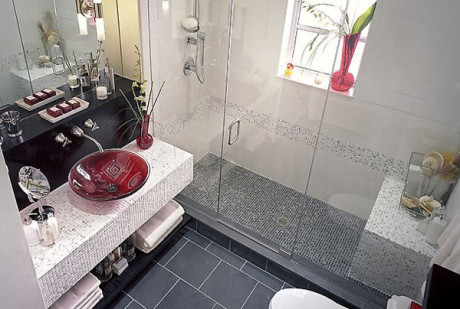
Do not give up the windows, which are often located on the wall bordering the kitchen. They not only add light, but can become a highlight if you show your imagination. You can insert colored glass into them or place additional lighting.
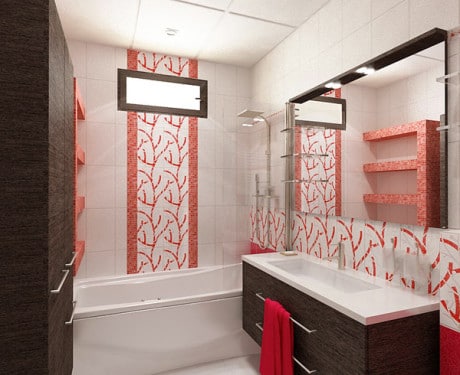
Even an unsightly window between the kitchen and the bathroom can be organically integrated into the design, making it a highlight of the interior
When choosing an apartment, you need to take into account the typical sizes of bathrooms and be sure to pay attention to these indicators. In this way, you will be able to avoid inconveniences in the future and get only pleasure from the new home, feeling comfortable. If there are people with disabilities in the family, the size of the bathroom for the disabled and the requirements for their arrangement should be clearly controlled, because this is a matter of not only convenience, but also safety.



